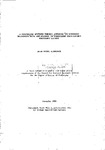A CONTINUUM MIXTURE THEORY APPROACH TO SEDIMENT TRANSPORT WITH APPLICATION TO TURBULENT OSCILLATORY BOUNDARY LAYERS
| dc.contributor.author | ALDRIDGE, JOHN NIGEL | |
| dc.contributor.other | School of Geography, Earth and Environmental Sciences | en_US |
| dc.date.accessioned | 2013-09-19T13:46:19Z | |
| dc.date.available | 2013-09-19T13:46:19Z | |
| dc.date.issued | 1990 | |
| dc.identifier | NOT AVAILABLE | en_US |
| dc.identifier.uri | http://hdl.handle.net/10026.1/1897 | |
| dc.description.abstract |
Two aspects of the modelling of suspended sediment transport are investigated. One is the development of a theoretical base for sediment transport models starting from the continuum theory of immiscible mixtures (also know as two-phase flow theories). The other is a comparison with experimental data of numerical predictions from a number of turbulence models for oscillatory, turbulent boundary layer flow containing suspended sediment. A review is given of previous work that has applied continuum mixture theories to the field of sediment transport. Turbulent averaged forms of the mixture equations are presented and, in the dilute particle concentration limit and neglecting the effects of particle inertia, the equations are shown to reduce to those encountered in traditional approaches to modelling suspended sediment concentrations. Likewise, the equations governing the motion of the fluid phase reduce to standard forms, with the effect of the sediment particles appearing as a buoyancy term in the fluid momentum equation. Particle inertia is taken into account by expanding in terms of a non-dimensional parameter, the ratio of the response time of the particle to a characteristic time of the flow. Terms arising from particle inertia are then reduced to correlations for which models are available in the literature. The assumption of dilute particle concentrations is made throughout the derivation. An extensive comparison between a number of turbulence models is made by comparing numerical predictions with experimental data, whilst making the conventional assumption of zero particle inertia. The k - c model was found to perform well, with simpler models also giving reasonable agreement with experiment. Also investigated is the sensitivity of the solution to a number of factors, including: boundary conditions, empirical turbulence constants, and the stratifying effect of the suspended sediment. The effect of including terms associated with particle inertia are investigated in turbulent oscillatory boundary layer flows. This is found to lead to an enhancement of the vertical particle volume flux. However, given the uncertainties of specifying the boundary condition for the concentration at the bed, the effect is probably not of significance for small particles (diameter - 0.1 mm). Larger particles (diameter 0.25 mm) show more significant effects due to their inertia. The difference in mean horizontal velocity between the fluid and particle phases which results from the inclusion of inertia in the particle momentum equations is calculated. This difference is found to be very small. | en_US |
| dc.description.sponsorship | Sir William Halcrow and Partners | en_US |
| dc.language.iso | en | en_US |
| dc.publisher | University of Plymouth | en_US |
| dc.title | A CONTINUUM MIXTURE THEORY APPROACH TO SEDIMENT TRANSPORT WITH APPLICATION TO TURBULENT OSCILLATORY BOUNDARY LAYERS | en_US |
| dc.type | Thesis | |
| plymouth.version | Full version | en_US |
| dc.identifier.doi | http://dx.doi.org/10.24382/4617 | |
| dc.identifier.doi | http://dx.doi.org/10.24382/4617 |
Files in this item
This item appears in the following Collection(s)
-
01 Research Theses Main Collection
Research Theses Main


